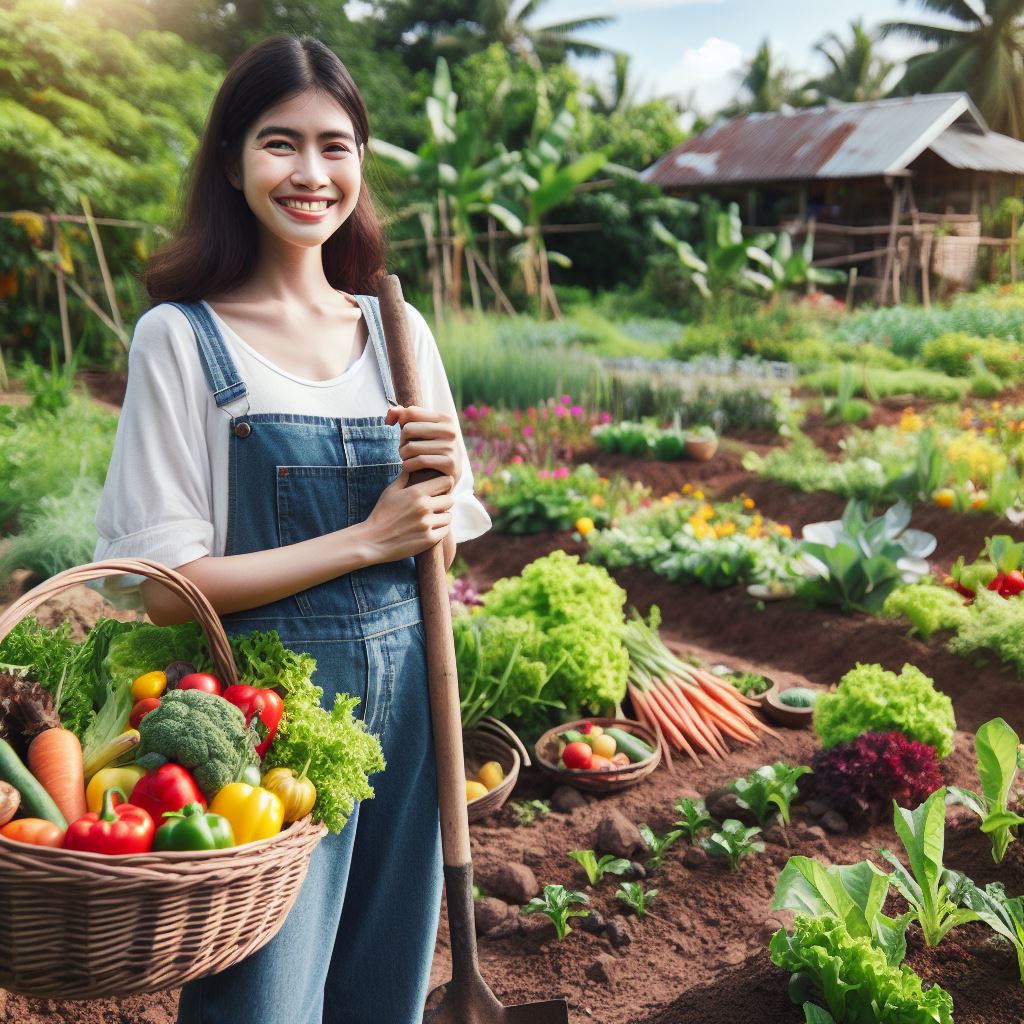Introduction
Continuous harvest is a gardening technique that involves planting crops in succession.
This means that instead of planting all of your desired vegetables at once, you stagger the planting dates to ensure a continuous supply of fresh produce throughout the growing season.
Planting for continuous harvest has several benefits and importance.
Firstly, it maximizes the use of available space in your garden, allowing you to grow a greater variety of crops and increase overall yields.
It also helps to reduce waste, as you can harvest smaller quantities of crops as they ripen, avoiding a surplus that may go to waste.
Additionally, continuous harvest ensures a consistently fresh and flavorful supply of vegetables, as they are harvested at their peak ripeness.
This ensures that you and your family can enjoy the tastiest and most nutritious produce straight from your garden.
In this blog section, we will explore various strategies for planting for continuous harvest, such as intercropping, successional sowing, and using companion planting techniques.
We will also discuss the importance of planning and organization, as well as tips for extending the harvest season.
By implementing these techniques, you can create a garden that will provide a steady stream of fresh vegetables throughout the growing season.
So let’s dive in and discover how to plant for continuous harvest and enjoy the benefits of a bountiful and abundant garden.
Selecting appropriate crops for continuous harvest
In order to achieve a continuous harvest in your garden, it is essential to select appropriate crops that can be grown and harvested throughout the season.
This involves considering the plant growth habit, maturity time, and various other factors that determine the optimal crops for continuous harvest.
Consideration of plant growth habit and maturity time
When selecting crops for continuous harvest, it is important to take into account their growth habit and maturity time.
Some plants have a determinate growth habit, which means they grow to a certain size and then stop.
Transform Your Agribusiness
Unlock your farm's potential with expert advice tailored to your needs. Get actionable steps that drive real results.
Get StartedOn the other hand, indeterminate plants continue to grow and produce fruits or vegetables until they are killed by frost or some other factor.
The maturity time of the crops is also crucial. It varies from crop to crop, and it determines how long it will take for the plants to produce edible fruits or vegetables.
For a continuous harvest, you need to choose crops with staggered maturity times so that you can harvest them at different intervals throughout the season.
Optimal crops for continuous harvest
Several crops are well-suited for continuous harvest due to their growth habit and maturity time. Here are some examples:
- Tomatoes: Indeterminate tomato plants continue to produce fruits until they are killed by frost.
- Beans: Both pole beans and bush beans can be harvested repeatedly throughout the season.
- Lettuce: Leaf lettuce varieties can be harvested by picking the outer leaves, allowing the plant to continue growing.
- Peppers: Many pepper varieties produce fruits continuously as long as you keep harvesting them.
- Herbs: Herbs like basil, cilantro, and parsley can be harvested as needed throughout the season.
These crops are excellent choices for continuous harvest because they either have an indeterminate growth habit or can be harvested repeatedly without damaging the plant.
Factors to consider when selecting crops for continuous harvest
Aside from growth habit and maturity time, there are other factors to consider when deciding which crops to grow for continuous harvest:
- Climate and growing conditions: Ensure that the crops you choose are suitable for your climate and can thrive in the available growing conditions.
- Succession planting: Plan your planting schedule and consider staggering plantings to ensure a continuous supply of harvestable crops.
- Yield and storage: Take into account the yield of the crops and whether they can be stored for extended periods, allowing you to enjoy their harvest beyond the growing season.
- Personal preferences: Select crops that you and your family enjoy eating to make the most of your continuous harvest.
By taking these factors into consideration, you can choose the right crops for continuous harvest based on your specific needs and preferences.
In essence, selecting appropriate crops for continuous harvest involves considering the plant growth habit, maturity time, and various other factors that determine the optimal crops.
With careful planning and consideration, you can enjoy a bountiful and continuous harvest throughout the growing season.
Planning and Scheduling Planting Activities
A well-planned and organized planting schedule is crucial for achieving a continuous harvest throughout the growing season.
By creating a planting calendar, using succession planting techniques, and rotating crops, you can maximize your harvest opportunities.
Creating a Planting Calendar
- Start by determining the average frost dates for your specific region.
- Research the recommended planting dates for different crops in your area.
- Take into account the specific requirements of each crop, such as soil temperature and sunlight.
- Create a calendar, either digitally or on paper, to map out your planting schedule.
- Include the planting dates, expected harvest dates, and any necessary reminders or notes.
- Consider using color-coding or symbols to distinguish between different types of plants.
- Regularly review and update your calendar to account for any changes or adjustments to your plans.
Succession Planting Techniques
- Succession planting involves staggering the planting of crops at regular intervals.
- By doing this, you can ensure a continuous supply of fresh produce throughout the growing season.
- Plant a new round of seeds or seedlings as soon as the previous plants reach maturity or are harvested.
- Make sure to factor in the crop’s maturation time when determining the interval between plantings.
- Consider using fast-maturing varieties for quicker turnover and more frequent harvests.
- Succession planting also helps manage potential crop failures or pest infestations.
Rotating Crops to Maximize Harvest Opportunities
- Rotating crops involves changing the planting location of different crops each year.
- This practice helps prevent the buildup of pests and diseases in the soil.
- Divide your garden into sections and assign specific crop families to each section.
- Follow a rotation cycle, avoiding planting crops from the same family in the same section more than once every few years.
- By rotating crops, you can maximize soil fertility and minimize the need for chemical inputs.
- This technique also helps break pest and disease cycles, reducing the risk of crop damage.
By incorporating these planning and scheduling techniques into your planting activities, you can ensure a continuous harvest throughout the growing season.
A well-organized planting calendar, combined with succession planting and crop rotation, will optimize your garden’s productivity and overall success.
Proper soil preparation
Importance of soil fertility and health
- Healthy soil is vital for continuous harvests as it provides essential nutrients to plants.
- Fertile soil promotes vigorous growth, leading to high-quality and abundant produce.
- Nutrient-rich soil enhances plant resistance to diseases and pests, ensuring a successful harvest.
- Soil health also plays a crucial role in water retention, preventing plants from drying out.
Soil testing and amendments
- Conducting soil tests is essential to determine the nutrient levels and pH balance.
- Testing helps identify deficiencies and excesses, allowing for targeted amendments.
- Adding organic matter, such as compost or manure, improves soil structure and nutrient content.
- Adjusting the pH levels with lime or sulfur ensures optimal conditions for plant growth.
- Incorporating organic fertilizers can replenish essential nutrients and support soil health.
Optimal planting techniques for continuous harvest
- Crop rotation is a useful technique to prevent the depletion of specific nutrients.
- Alternating crops also breaks pest and disease cycles, reducing the need for chemical interventions.
- Interplanting compatible species optimizes space and promotes biodiversity, enhancing overall plant health.
- Using raised beds or containers provides better control over soil quality and drainage.
- Employing mulching helps regulate soil temperature, retain moisture, and suppress weed growth.
In fact, proper soil preparation is crucial for achieving a continuous harvest. Soil fertility and health ensure plants receive necessary nutrients, resist diseases and pests, and retain moisture.
Conducting soil tests, making appropriate amendments, and using optimal planting techniques contribute to a thriving garden.
By following these practices, gardeners can maximize yields and enjoy a bountiful, year-round harvest.
Intercropping and companion planting strategies
Intercropping and companion planting are effective strategies for achieving a continuous harvest in your garden.
By planting compatible plants together, you can maximize space and resources while also benefiting from natural pest and disease control.
In this section, we will explore the benefits of intercropping and companion planting, compatible plant combinations for continuous harvest, and pest and disease control methods.
Benefits of Intercropping and Companion Planting
- Increased yield: When you intercrop or companion plant, you can grow more plants in the same space, resulting in higher crop yields.
- Space optimization: Utilizing intercropping and companion planting allows you to make the most efficient use of your garden space.
- Soil improvement: Certain plant combinations, such as legumes and leafy greens, can improve soil fertility by fixing nitrogen.
- Weed suppression: When plants are densely packed together, they naturally shade the soil, preventing weed growth.
- Increased biodiversity: Intercropping and companion planting promote biodiversity by attracting beneficial insects and pollinators to your garden.
Compatible Plant Combinations for Continuous Harvest
- Carrots and onions: Carrots serve as a natural pest deterrent for onions, while onions deter carrot flies.
- Beans and corn: Beans fix nitrogen in the soil, benefiting corn growth, while corn provides support for the climbing beans.
- Tomatoes and basil: Basil repels pests that attack tomatoes, while tomatoes provide shade and support for basil plants.
- Cabbage and dill: Dill attracts beneficial insects that prey on cabbage pests, improving overall cabbage health.
- Lettuce and radishes: Radishes act as living mulch, shading the soil and reducing weeds, benefiting lettuce growth.
Pest and Disease Control in Intercropped or Companion Planted Crops
- Natural pest control: Intercropping and companion planting can disrupt pest life cycles by confusing or repelling them.
- Camouflage and masking scents: Certain companion plants emit strong scents that either mask or confuse pests.
- Beneficial insect attraction: Companion planting can attract predatory insects that feed on garden pests, providing natural pest control.
- Disease prevention: By diversifying your garden with different plant species, you can reduce the risk of disease outbreaks.
In general, intercropping and companion planting offer a range of benefits for achieving a continuous harvest in your garden.
By carefully selecting compatible plant combinations and implementing pest and disease control measures, you can optimize space, increase yield, and promote overall garden health.
Consider trying these strategies in your garden to enjoy a bountiful and thriving harvest throughout the growing season.
Read: Improving Soil: Natural Methods

Ensuring optimal growing conditions
Achieving continuous harvests requires providing plants with the right conditions to thrive and produce abundant yields. Here are some essential techniques:
Showcase Your Farming Business
Publish your professional farming services profile on our blog for a one-time fee of $200 and reach a dedicated audience of farmers and agribusiness owners.
Publish Your ProfileProper watering and irrigation techniques
- Water plants consistently to ensure they receive adequate hydration for optimal growth.
- Use methods such as drip irrigation or soaker hoses to deliver water directly to plant roots.
- Avoid overhead watering to minimize the risk of diseases caused by splashing water.
- Monitor soil moisture levels regularly using tools like moisture meters or performing the finger test.
- Adjust watering frequency and duration based on plant needs and environmental conditions.
Mulching and weed control
- Apply organic mulch around plants to retain moisture, regulate soil temperature, and suppress weed growth.
- Examples of suitable mulch materials include straw, wood chips, leaves, or grass clippings.
- Keep mulch away from the plant stems to prevent rot and pests from hiding.
- Regularly inspect and remove weeds to prevent competition for water, nutrients, and sunlight.
- Use hand pulling, hoeing, or safe herbicides to control weeds effectively without harming crops.
Protecting crops from extreme weather conditions
- Install row covers or hoop houses to shield plants from harsh temperatures, frost, or high winds.
- Use shade cloth to protect tender plants from excessive heat and sun exposure.
- Provide support structures like stakes or trellises to protect plants from heavy rain or wind damage.
- Employ techniques like crop rotation and companion planting to reduce the risk of pest and disease infestations.
- Stay informed about local weather forecasts to take preventative measures against severe weather events.
By implementing these practices, gardeners can create an environment that maximizes plant health and encourages continuous production. Remember, each step is vital in ensuring a bountiful and uninterrupted harvest.
Read: Best Times to Harvest Corn: Key Tips & Tricks
Explore Further: Soil Testing Before Planting
Harvesting and post-harvest handling
Identifying crop readiness for harvest
- Observe the plant’s appearance, size, and color to determine if it is ready for harvest.
- Check for maturity indicators such as fruit size, texture, and taste.
- Perform a squeezing test to see if the crop is firm and ripe.
- Take note of the number of days since planting to estimate the harvest time.
Techniques for harvesting without affecting future crops
- Use sharp and clean tools to minimize damage to the plant during harvesting.
- Harvest only the ripe crops to ensure there are still immature ones left for future harvest.
- Avoid stepping on or damaging surrounding plants while harvesting.
- Handle the harvested produce with care to prevent bruising or other damages.
Proper storage and preservation of harvested produce
- Sort the harvested produce according to size, quality, and ripeness.
- Remove any damaged or spoiled crops to prevent the spread of decay.
- Clean the harvested produce gently to remove dirt and debris.
- Choose appropriate storage containers or bags that provide proper ventilation and prevent moisture buildup.
- Store the harvested produce in a cool and dry place to prolong its shelf life.
- Monitor the stored produce regularly, checking for any signs of spoilage or decay.
- Consider using preservation techniques like canning, freezing, or drying to extend the shelf life of the produce.
- Label the stored produce with the date of harvest to ensure proper rotation and use.
- Handle the stored produce carefully to avoid bruising or damage during transportation or handling.
By following these guidelines for harvesting and post-harvest handling, you can ensure a continuous supply of fresh and quality produce throughout the growing season.
Read: Sustainable Water Use in Farms
Troubleshooting common challenges in continuous harvest
Pest and disease management
- Pest and diseases are common problems in continuous harvest.
- Regularly inspect plants for pest infestations and signs of diseases.
- Identify pests and diseases early to prevent their spread.
- Implement cultural practices like crop rotation and sanitation to minimize pest and disease incidences.
- Use organic pest control methods such as beneficial insects, traps, and companion planting.
- If necessary, resort to chemical pesticides, but follow instructions carefully and use them as a last resort.
- Maintain good plant health through proper watering, nutrition, and overall care to prevent susceptibility to pests and diseases.
Soil nutrient imbalances
- Soil nutrient imbalances can affect the growth and productivity of plants in continuous harvest.
- Test the soil periodically to determine its nutrient content and pH levels.
- Correct nutrient imbalances by adding organic matter or applying appropriate fertilizers based on soil test results.
- Avoid over-fertilization, as it can lead to nutrient runoff and environmental pollution.
- Monitor plant symptoms for nutrient deficiencies or toxicities, such as yellowing leaves or stunted growth.
- Adjust fertilizer applications accordingly, providing plants with the necessary nutrients in the right quantities.
- Practice crop rotation to balance soil nutrient levels and prevent depletion of specific nutrients.
Weed control strategies
- Weeds can compete with plants for nutrients, water, and sunlight in continuous harvest.
- Implement preventive measures like mulching and weed barrier fabrics to suppress weed growth.
- Regularly remove weeds by hand or using appropriate tools to prevent them from overtaking the garden.
- Use herbicides sparingly and selectively, targeting specific weed species while minimizing harm to desirable plants.
- Encourage healthy plant growth through proper spacing and adequate nourishment to create a competitive advantage against weeds.
- Consider using cover crops that smother weeds and improve soil health during fallow periods.
- Maintain a diligent weed management schedule to stay ahead of weed growth and prevent them from setting seed.
Gardening with continuous harvest can present several challenges that need to be addressed promptly.
From pest and disease management to soil nutrient imbalances and weed control strategies, it’s important to tackle these issues to ensure a bountiful and successful harvest.
Regularly inspecting plants for pest infestations and diseases is crucial in order to identify them early and prevent their spread.
Cultural practices such as crop rotation and sanitation also play a vital role in minimizing the occurrence of pests and diseases.
When it comes to soil nutrient imbalances, testing the soil periodically helps determine its nutrient content and pH levels.
By addressing nutrient deficiencies or toxicities through the appropriate use of organic matter or fertilizers, plants can thrive and produce quality harvests.
Weed control is another key aspect of continuous harvest. Weeds can compete with plants for essential resources, so preventive measures like mulching and weed barrier fabrics can be highly effective.
Regularly removing weeds by hand or using tools is also important to prevent them from overpowering the garden.
For more stubborn weed problems, herbicides can be used selectively, minimizing harm to desirable plants. Additionally, creating optimal growing conditions for plants, such as proper spacing and nourishment, can give them a competitive edge against weeds.
Consideration of cover crops during fallow periods can also help prevent weed growth and improve soil health.
Overall, maintaining good plant health, addressing pest and disease issues promptly, managing nutrient imbalances, and adopting effective weed control strategies are essential for successful continuous harvest.
By troubleshooting these challenges proactively, gardeners can consistently enjoy a productive and abundant harvest throughout the year.
Read: Preventing Soil Erosion Naturally
Uncover the Details: Tech Tools Transforming Modern Crop Cultivation
Conclusion
In this section we discussed the key points of planting for continuous harvest. The importance of continuous harvest for sustainable farming was highlighted.
Continuous harvest is crucial for sustainable farming as it promotes resource efficiency, maintains soil health, and ensures a steady food supply.
By harvesting crops in a staggered manner, farmers reduce soil degradation, prevent nutrient depletion, and minimize the need for chemical inputs.
This practice supports biodiversity, as it allows ecosystems to thrive without the disruption of mass harvests.
Additionally, continuous harvests contribute to a more stable income for farmers, enhancing economic sustainability.
Overall, adopting a strategy of ongoing, selective harvests is essential for preserving agricultural ecosystems, safeguarding food security, and promoting long-term environmental and economic viability.
We encourage readers to implement planting practices that promote continuous harvest to ensure long-term success in farming.




